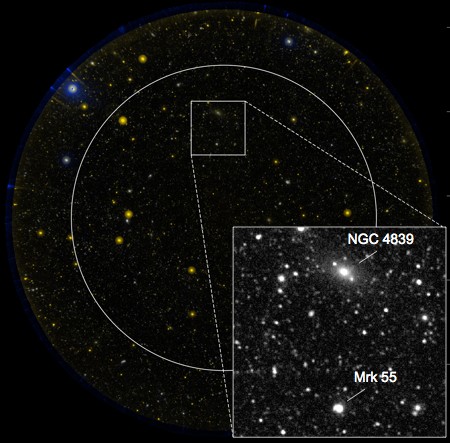Galaxy Evolution Explorer (GALEX)
GALEX is the acronym given to the Galaxy Evolution Explorer, a satellite telescope sensitive to ultraviolet radiation. It was launched by NASA in 2003 and orbits the Earth at an altitude of 700 km.

Web Site: http://www.galex.caltech.edu/
Lead Investigators: Derek Hammer and Ann Hornschemeier
The ultraviolet (UV) emission from galaxies can originate from either young stellar populations born in recent star formation episodes or from old (post main-sequence) stars in evolved galaxies. This unique property of UV emission allows astronomers to estimate the stellar ages of galaxies at various stages of evolution: which is ideal for the wide range of galaxy types within the galaxy cluster environment. The Coma cluster is the nearest example of a rich cluster environment, it has therefore been the subject of numerous multiwavelength surveys from X-ray to radio wavelengths. However, previous UV observations in Coma have been limited to the bright star forming galaxies. Because the Earth's atmosphere blocks UV rays (otherwise we would all be terribly sunburnt) telescopes with UV-sensitive detectors must be located in space.
GALEX has significantly improved the capability of performing UV surveys due to its large field-of-view, better light sensitivity and higher spatial resolution (compared to UV balloon experiments nearly two decades ago which had previously provided the best coverage of the Coma cluster). A deep GALEX observation has been performed at the infall region of the Coma cluster, which for the first time allows us to study the UV properties of a relatively large sample of dwarf galaxies within the Coma cluster.
It is well known that cluster environments harbor large numbers of dwarf galaxies compared to the field environment, yet the origin of these galaxies are poorly understood. Current theories (hierarchical cold dark matter models) predict an intrinsic population of old metal-poor dwarf elliptical galaxies that were members of the original cluster. The large dwarf elliptical galaxy population may however also result from infalling spiral galaxies that are morphologically transformed into elliptical galaxies via dynamical processes within the cluster environment that tend to operate more efficiently on low-mass galaxies. The Coma cluster Treasury Survey will place strong constraints on the formation and evolution of cluster dwarf galaxies by: (i) extending the UV luminosity function some three magnitudes deeper than previous efforts and thereby for the first time including dwarf elliptical galaxies in a UV luminosity function for a galaxy cluster, (ii) measuring the relative abundance of dwarf galaxies according to stellar age, and (iii) characterizing the star formation histories of transition galaxies (passive spiral galaxies not forming stars) which hold clues to the dynamical processes responsible for their transformation.

A two-color (NUV+FUV) GALEX image of the Coma cluster, including an inset (9x9 arcminute) NUV band image.
The white circle, with a radius of 0.45 degrees, shows the region of our GALEX FOV with good
spectroscopic redshift coverage from the MMT-Hectospec program. Image taken from
D.Hammer et al. (2008).
